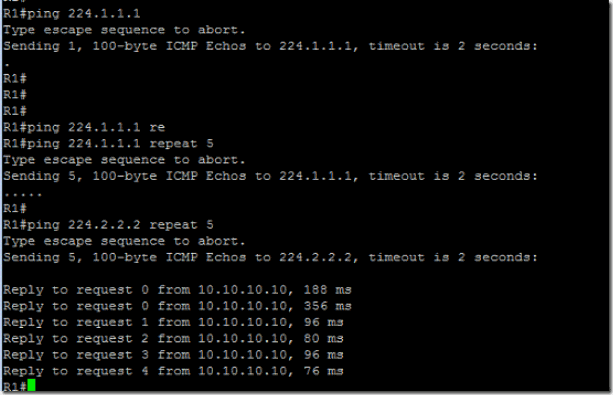Sometimes either there is no group member on a network segment or a host cannot report its group membership using IGMP. However, you may want multicast traffic to go to that network segment. The following are two ways to pull multicast traffic down to a network segment:
?![]() Use the ip igmp join-group interface configuration command. With this method, the router accepts the multicast packets in addition to forwarding them. Accepting the multicast packets prevents the router from fast switching.
Use the ip igmp join-group interface configuration command. With this method, the router accepts the multicast packets in addition to forwarding them. Accepting the multicast packets prevents the router from fast switching.
?![]() Use the ip igmp static-group interface configuration command. With this method, the router does not accept the packets itself, but only forwards them. Hence, this method allows fast switching. The outgoing interface appears in the IGMP cache, but the router itself is not a member, as evidenced by lack of an "L" (local) flag in the multicast route entry.
Use the ip igmp static-group interface configuration command. With this method, the router does not accept the packets itself, but only forwards them. Hence, this method allows fast switching. The outgoing interface appears in the IGMP cache, but the router itself is not a member, as evidenced by lack of an "L" (local) flag in the multicast route entry.
相同点:
在接口下所连接的设备没有发igmp report报文的能力的时候,可以在接口上使用这两个命令把组播流引下来.
不同点:
join-group, 这个接口就模拟成PC发了IGMP report报文,这个接口就是接收者且也转发配置的组播流量out这个接口. 此时尽管这个接口下面没有接任何设备,在上端PING这个组播地址时,有反馈(因为它就是接收者). 这时叶路由器发pim join (*,G)到RP.
使用static-group, 表示这个接口加入了配置的组播地址,它可以转流量out这个接口,这个接口不是接收者,它所下挂的设备是接收者. 此时如果这个接口下面没有接任何设备,在上端PING这个组播地址时,没有反馈(因为它不是接收者). 这时叶路由器也发pim join(*,G)到RP.
在show ip mroute时, join-group带’L’标识,表示local,此接口是member成员.
R3(config)#int lo0
R3(config-if)#ip igmp join-group 224.100.100.100
R3(config-if)#int s0/0
R3(config-if)#ip igmp static-group 232.100.100.100
R3(config-if)#do sho ip mroute
IP Multicast Routing Table
Flags: D - Dense, S - Sparse, B - Bidir Group, s - SSM Group, C - Connected,
L - Local, P - Pruned, R - RP-bit set, F - Register flag,
T - SPT-bit set, J - Join SPT, M - MSDP created entry,
X - Proxy Join Timer Running, A - Candidate for MSDP Advertisement,
U - URD, I - Received Source Specific Host Report,
Z - Multicast Tunnel, z - MDT-data group sender,
Y - Joined MDT-data group, y - Sending to MDT-data group
Outgoing interface flags: H - Hardware switched, A - Assert winner
Timers: Uptime/Expires
Interface state: Interface, Next-Hop or VCD, State/Mode
(*, 232.100.100.100), 00:00:03/00:02:56, RP 2.2.2.2, flags: SJC
Incoming interface: Serial0/1, RPF nbr 192.1.13.1
Outgoing interface list:
Serial0/0, Forward/Sparse, 00:00:03/00:02:56
(*, 224.100.100.100), 00:00:14/00:02:45, RP 2.2.2.2, flags: SJCL
Incoming interface: Serial0/1, RPF nbr 192.1.13.1
Outgoing interface list:
Loopback0, Forward/Sparse, 00:00:14/00:02:45
这里再举一个例子:
在路由器上面配置:
然后在该路由器上面show可以看到:
在这里,mroute 表中,(*,224.2.2.2)的表项是带L标志位的,证明224.2.2.2是join-group.并且可以看到, last reporter是10.10.10.10,我们再路由器上面配置的loopback0接口,他已经代替下面的组播客户端发送IGMP report上去了。而224.1.1.1,是静态加入的组,expire字段是停止的,因为下面根本就没有接收者。
从另外一个路由器上面,ping 224.1.1.1 和ping 224.2.2.2结果是完全不一样的。


